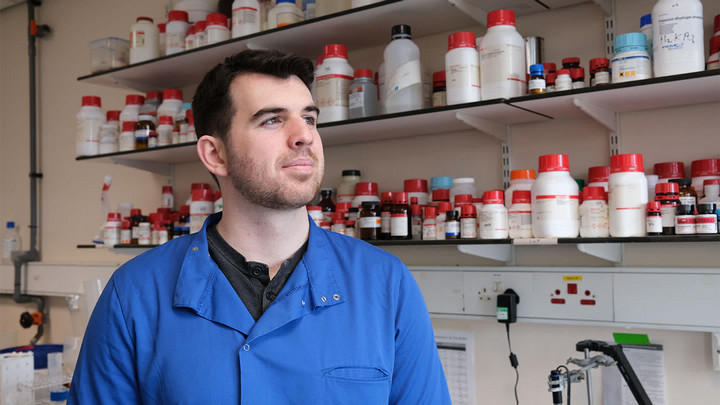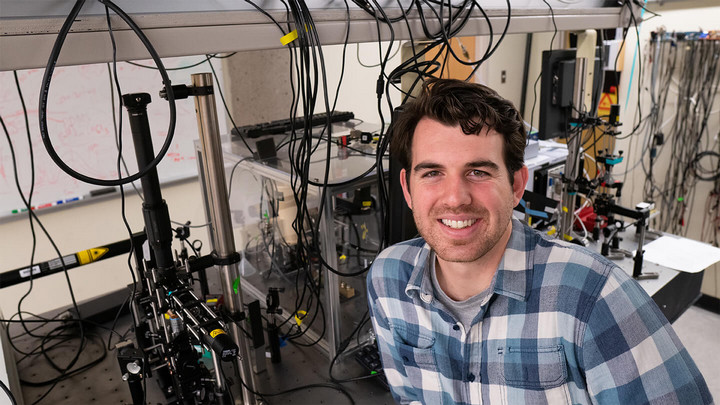A shot to save lives
December 04, 2024

UVic grad Rory Hills is working on an ingenious nanoparticle vaccine that could be a game changer in protecting against coronaviruses, including ones not yet discovered.
Rory Hills grew up in Victoria as a curious kid who was wild about science and the natural world. Later, as a student at UVic, he became involved in a new project to test the composition of street drugs. He realized something else through that work: science can make a big difference. The project, led by chemistry professor Dennis Hore, helped set Hills on his current path.
The hands-on, ground-level research experience was demanding and convinced him that doing meaningful science was his calling. “Dennis taught me what it meant to be a scientist. The work I did with him on the drug-checking project converted my curiosity-driven interest in science into a passion for doing practical research that could actually help people,” says Hills.
He has followed that thread ever since. After earning an honours degree in biochemistry in 2020, Hills became a Rhodes Scholar. In his current work, he aims to get an edge on the next pandemic by creating a multi-purpose vaccine that could protect against viruses that haven’t even emerged yet. As first author of a recent cutting-edge study in Nature Nanotechnology, Hills demonstrated that a new nanoparticle vaccine with unusual properties is effective against several different coronaviruses, including viruses not represented in the vaccine.
“We’ve shown in a pre-clinical model that a relatively simple vaccine can raise an immune response to a broad range of coronaviruses, including related viruses that are still unknown and yet to be identified. Our goal is to have effective, broad-spectrum vaccines ready for Day 1 of the next pandemic threat, which could be rapidly scaled up for mass production, if needed,” says Hills, who is doing a DPhil (PhD) at University of Oxford and is a visiting student at University of Cambridge in protein biologist Mark Howarth’s lab.
Hills’ innovative research is at the forefront of a new vaccine strategy that anticipates future pandemic threats with proactive, all-in-one vaccines. “This experimental vaccine against multiple coronaviruses is a key step towards our goal of ‘proactive vaccinology,’ where vaccines are designed and readied for manufacture before a potentially pandemic virus can infect humans,” explains Hills, who uses synthetic biology and protein engineering to develop new vaccine technologies that could potentially guard against a wide range of pathogens including coronaviruses, influenza, rhinovirus, HIV and mpox.

Creative scientific thinking to solve real-world problems
Even as a youth, Hills had an omnivorous appetite for science, nurtured by his empathic, nature-loving parents. “As a kid I was obsessed with food chains and the plight of endangered animals, and my parents took me to every nature program available,” he recalls. Years later, as a teenager, Hills began to see how science is connected to broader social issues and can be instrumental in understanding and solving these problems—after hearing UVic researcher and former Green Party leader Andrew Weaver talk about the impact of climate change.
As a biochemistry major at UVic in 2018, he was the first student hired and helped to launch the Substance Drug Checking pilot project, led by Prof. Hore and social work professor Bruce Wallace. The interdisciplinary project provided users of illicit street drugs with quick, accurate chemical analyses of drugs, including the main active ingredient and contaminants including trace amounts of fentanyl—to prevent opioid overdoses.
“I jumped at the opportunity to use my analytical chemistry knowledge and skills to help with the opioid crisis and do something that could save lives. My job was to analyze all the substances in street drugs and allow each person to make an informed decision about the risks,” says Hills, who knew peers who had died from drug overdoses. The project team has since expanded to more than 20 people and offers drug-checking services at six other sites on the Island.
For his undergraduate honours project, Hills pivoted back to the challenge of climate change by investigating and characterizing novel proteins from bacteria in the human gut, which could potentially be used to generate biofuels from seaweed.
The hands-on experience and knowledge gained at UVic gave him the confidence to apply for a Rhodes Scholarship at Oxford. Hills thought he’d botched the final interview, which took place in November of 2019.
“I was having a meal with my girlfriend and other friends later that day, feeling dejected. I got the good news in a call at the restaurant and getting to share that moment with them was really special,” he recalls.
Engineering a universal vaccine with protein superglue
He headed to Oxford in the fall of 2020. “I had been interested in working on cancer vaccines and then COVID happened,” says Hills, who was looking for a lab that would be the right fit. “I was attracted to Mark Howarth’s lab because of the diversity of projects, our common interest in synthetic biology and new vaccine technologies, and most importantly, he was always thinking about how the research could be clinically applied. I’d spoken with other academics who didn’t think about that.”
In Howarth’s lab, Hills led the development of an ingenious, all-in-one nanoparticle vaccine that combines a mix of key protein fragments—known as receptor-binding domains (RBDs)—located on the spike proteins of eight different sarbecoviruses (a coronavirus subgroup that includes the virus that caused the 2002-04 SARS outbreak). The vaccine contains RBDs from SARS-CoV-2 and several bat and pangolin sarbecoviruses with the potential to infect humans. “As a virus evolves, some parts of it change while other parts stay the same. Our vaccine incorporates evolutionarily related RBDs from eight coronaviruses, so that a single vaccine trains the immune system to respond to parts of the viruses that remain unchanged,” he explains. “This protects against diverse known coronaviruses and also related viruses that haven’t yet been discovered.”
Working closely with researchers in Howarth’s lab and collaborators from the University of Oxford and California Institute of Technology, Hills had the formidable task of creating a simpler version of a complex mosaic nanoparticle vaccine the group had developed earlier. “Despite its success in raising immune responses to different coronaviruses, the mosaic nanoparticle vaccine had many components and would have been difficult to produce on a large scale or validate with regulators,” says Hills, who became a visiting student at Cambridge after Howarth was appointed Sheild Professor of Pharmacology there in the fall of 2022.
Hills and his collaborators created a simpler, streamlined vaccine by genetically fusing RBDs from four different coronaviruses to form a single protein, called a quartet, and fusing four other RBDs to form a second quartet. “We use a protein superglue, called SpyTag, developed by our lab, to attach these two quartets to a protein nanocage, called SpyCatcher. The protein nanocage is a spherical nanoparticle held together by incredibly strong interactions,” he explains. “Remarkably, with just two (Quartet Nanocage) or three (Dual Quartet Nanocage) components, our streamlined vaccine managed to produce a higher level and broader range of neutralizing antibodies against a broad range of sarbecoviruses than the nine-component, mosaic nanoparticle vaccine.”
The next step will be to test this multi-viral vaccine in humans. “We’re working with companies now to demonstrate that this vaccine can be produced on a larger scale for testing in clinical trials,” says Hills.
Thinking big from a place of humility

Hills has the boldness, brilliance and passion to think big. But he also has the humility, self-deprecating humour and work ethic needed to survive and thrive in the high-octane Oxbridge (Oxford and Cambridge) research community, where being clever is a given. “Going to Oxford was a big jump for me. My first two years I was terrified about whether I deserved to be here and felt like an imposter,” he says. “Fortunately, I was well-prepared by UVic because there is a big emphasis on lab and practical skills, and on working hard to get meaningful scientific results. The scientific peers at my level here were supportive and Mark, who has incredibly high standards, gave me a sense of confidence and certainty that I would be able to do it.”
Hills is now focusing his PhD research on using new vaccine technologies to develop more effective HIV vaccines. His West Coast roots and love of nature keep him grounded while tackling mega-health challenges as a scientist in the nanoworld.
“My experience of culture on the Island is that people seek out a balance in their lives and try not to take themselves overly seriously,” he says.
“Being on the ocean, you feel very small and see yourself as part of something much bigger. I think that feeling is important. Solving real-world problems takes a lot of people working together towards the same horizon.”
—Mark Witten
This article appears in the UVic Torch alumni magazine.
For more Torch stories, go to the UVic Torch alumni magazine page.
